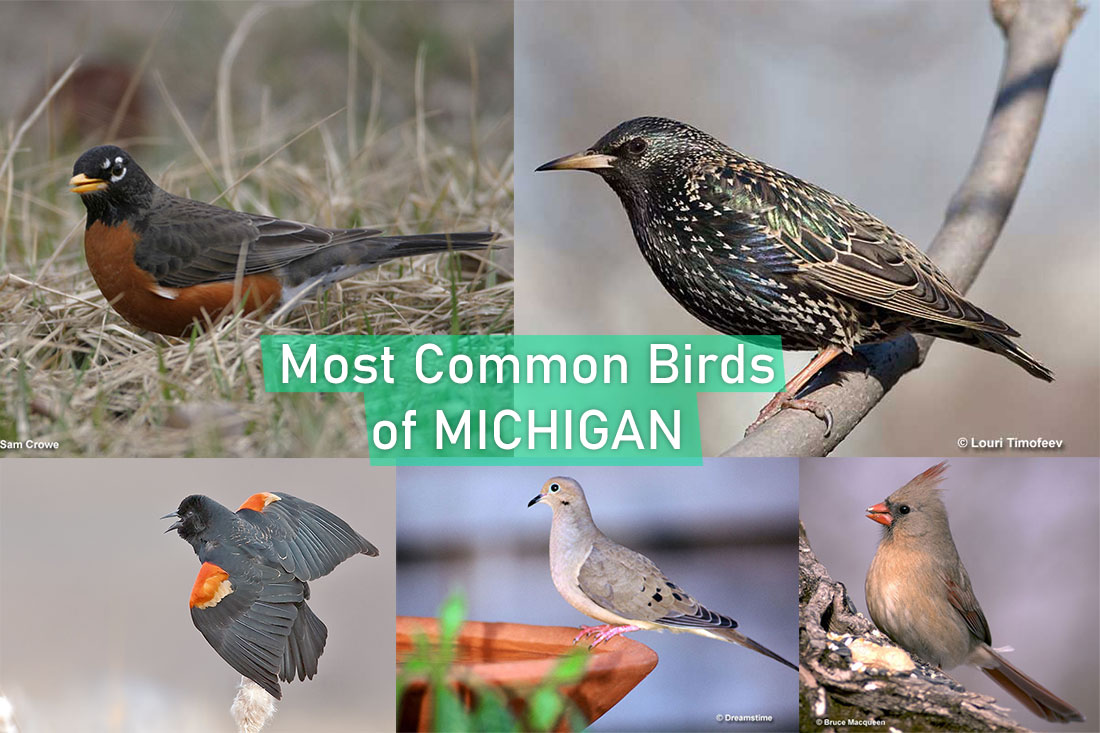
Michigan is a scenic place of lakes, forest, farmland and lots of birds. Home to Detroit and 10 million people, the “Great Lakes State” borders Lake Superior, Lake Michigan, Lake Huron, and Lake Erie.
With so much water, it’s no surprise that lakes and rivers make up 40% of Michigan’s 99,716 square miles. The wide variety of open water, wetland, and forest habitats in Michigan attract a large number of birds, enough to give the state a bird list of 459 species.
This bird list is larger than those of most other states and includes the official state bird of Michigan, the American Robin. This pleasant thrush is a common, beautiful, and familiar species frequently seen and heard throughout the state. It occurs in Michigan with many other common birds, including the ones listed below.
In this article, you’ll find all the necessary birding information about Michigan, including the most common birds and best birding locations.
On this page
- Birds You Can See The Most On Michigan
- 1. Red-winged Blackbirds
- 2. American Robins
- 3. European Starlings
- 4. Red-eyed Vireos
- 5. American Crows
- 6. House Sparrows
- 7. Mourning Doves
- 8. Chipping Sparrows
- 9. Song Sparrows
- 10. Common Grackles
- 11. Ovenbirds
- 12. Blue Jays
- 13. Northern Cardinals
- 14. Black-capped Chickadees
- 15. Barn Swallows
- 16. House Wrens
- 17. Common Yellowthroats
- 18. Cedar Waxwings
- 19. Indigo Buntings
- 20. American Goldfinchs
- 21. Canada Gooses
- Questions About Michigan Birds
Birds You Can See The Most On Michigan
According to our data from North America Breeding Birds Survey in 2021, these are the 21 most popular birds in Michigan.
1. Red-winged Blackbirds
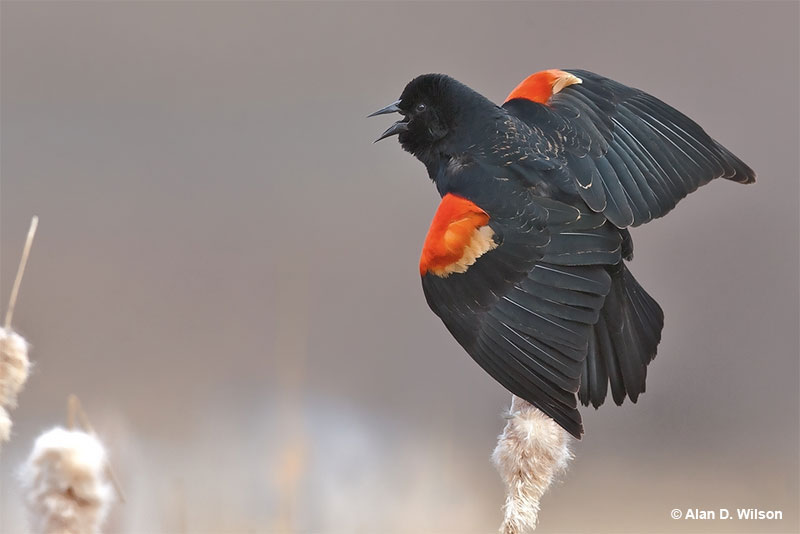
The Red-winged Blackbird is a medium-sized blackbird with a sharp bill, dark eye, and a rounded tail. The male Red-winged Blackbird is black except for a red shoulder bordered by a bit of yellow and white.
Female Red-winged Blackbirds are dark, mottled reddish brown above with some white streaks, and have white streaks on brownish gray underparts. They have a hint of pale wing bars, and buff on the throat and above the eye.
Red-winged Blackbirds feed on many grains and seeds including corn, sorghum, and sunflowers. In the winter, large flocks pick food from the ground of farm fields, marshes, and other open habitats. During the summer, they eat more insects and other arthropods, and occur in similar open habitats.
The song of the Red-winged Blackbird, “kon-ker-ee!” is often heard, and the bright red in the wings frequently seen as males display and chase each other over marshes, farm fields, and in parks.
2. American Robins
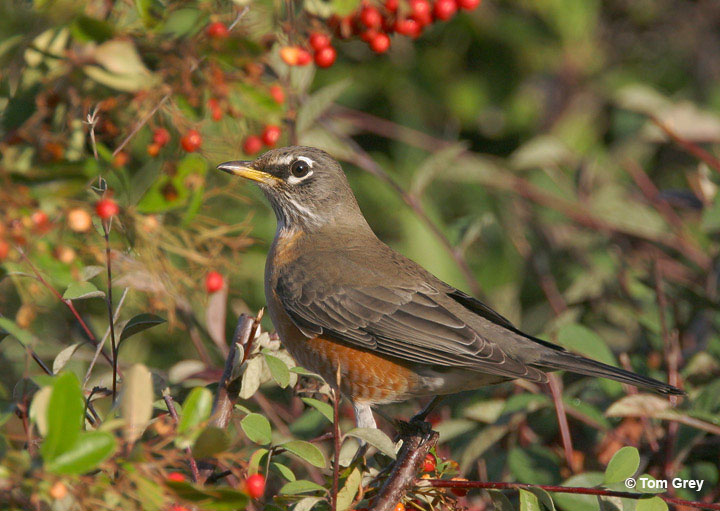
© Tom Grey
The American Robin is a fairly large thrush with a yellowish bill, blackish head, and reddish-orange underparts.
It also has white on the face, throat, and belly, gray on the back and long wings, and a long, blackish tail with a bit of white on the outer tail feathers.
Females look like males but are paler, more brown than gray, and can have small white marks on the underparts. Juveniles have pale spotting above and dark spotting on pale orange underparts.
American Robins are common backyard birds in Michigan. They forage for worms and bugs by standing on lawns and other open habitats and looking and listening until snatching the worm with its bill, often pulling it from the ground.
During the winter, this species mostly feeds on fruit in bushes and trees, especially crabapples and berries. At this time of year, they flock together and can form groups of birds that number in the thousands.
3. European Starlings
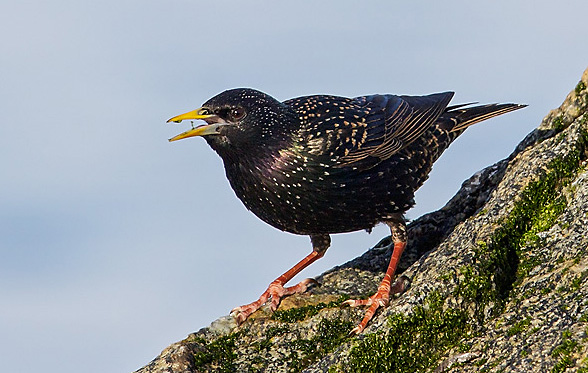
Photograph © Glenn Bartley.
The European Starling is a plump, thrush-sized bird with a sharp, pointed, yellowish bill, dark eye, long wings, a short tail, and strong legs and feet.
The breeding adult male is glossy purplish black with some green highlights, and has small pale and buff spots on the back, belly, and under the tail. The female looks similar but has more spotting on the head and underparts.
In winter, this species has a dark bill, is less black, more heavily spotted, and has reddish wings. Young starlings are plain gray with a pale throat.
The European Starling is very adaptable and feeds on a wide variety of insects, grains, seeds, acorns, and fruits. It forages by walking in farm fields, parks, and other open habitats, and then picking food from the ground with its bill.
This species also forms large flocks, especially during migration and the winter. Such flocks are known as “murmurations”.
4. Red-eyed Vireos
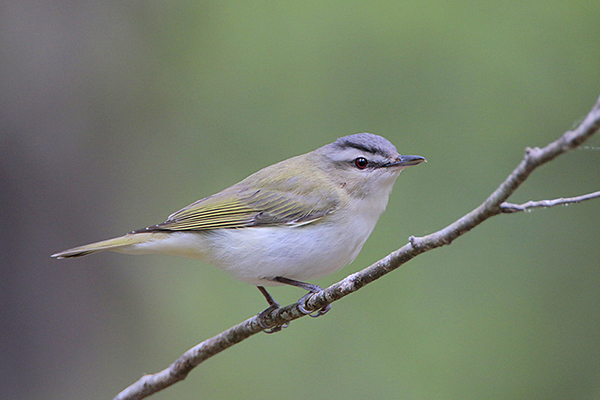
Photograph © Greg Lavaty.
The Red-eyed Vireo is a small, pale songbird with a longer and stronger bill than a warbler. Both sexes are olive above, white below, and have reddish eyes.
They also have a gray crown with a narrow black border, a pale eyebrow, a dark line through the eye, and some pale brown on the cheeks. The bill is grayish and has a small, hooked tip. Juveniles look like adults but have dark brown eyes.
The Red-eyed Vireo feeds on small larvae and other insects in large trees and forested habitats. It forages by carefully and diligently moving through the foliage and picking food items from stems and leaves.
In spring and summer, as males forage, they constantly sing, over and over, “See me…up here! Here I am…”. This long-distance migrant uses its long wings to migrate from Michigan to the Amazon.
5. American Crows
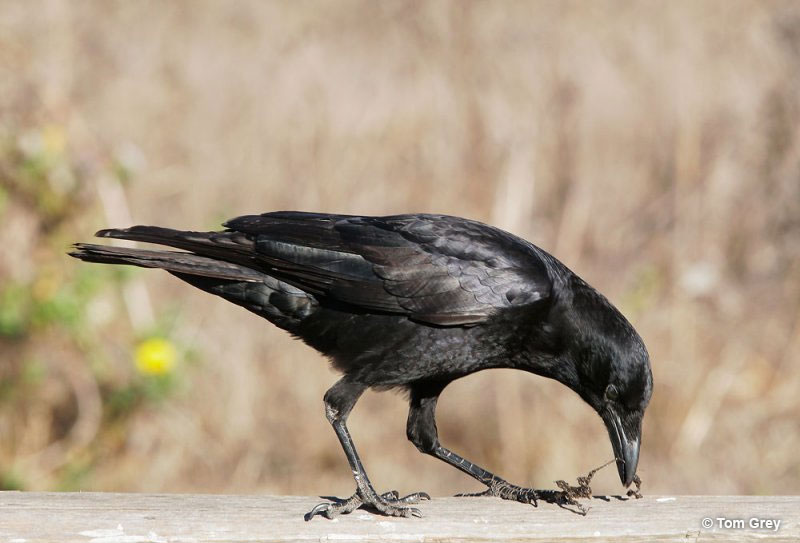
© Tom Grey
The American Crow is large, loud, and hard to ignore. Both sexes have entirely blackish plumage, strong legs and feet, and a strong, stout bill.
In certain lighting, the plumage can have a dark purplish or deep blue tinge but this can be hard to see. It has long wings that nearly reach the tip of the broad tail, and feathering on the upper part of the bill where it meets the face.
This species gives a variety of vocalizations but is mostly known for the often-heard “Caw! Caw!” call.
The American Crow is omnivorous and feeds on a wide variety of food items in many habitats. Their diet includes everything from seeds, grain, and fruits to insects, nestlings, bird eggs, small reptiles, amphibians, garbage, and carrion.
Although they can take food while perched, this species prefers to forage on the ground, usually in flocks. They often look for food at the edge of water or in wet spots and are quick to give the alarm if they spot a hawk, other predator, or a person.
6. House Sparrows
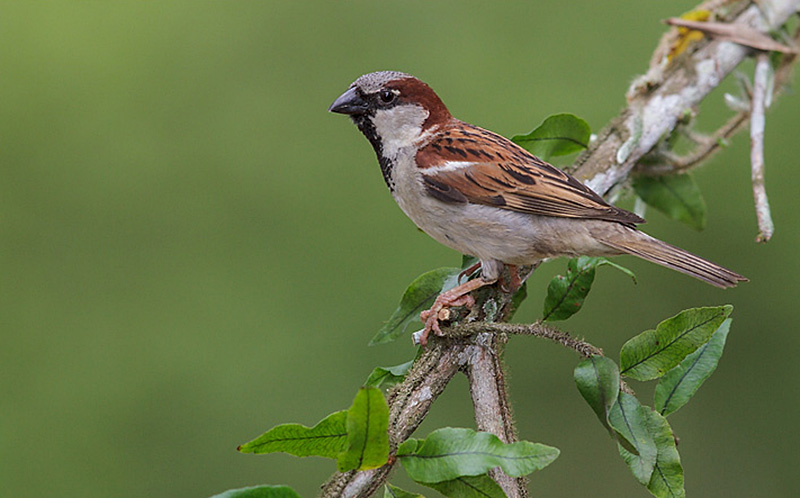
House Sparrow (Passer domesticus) perched on a branch in the Atlantic rainforest of southeast Brazil.
The House Sparrow is a small, brown bird with a conical, finch-like bill. The male has a black bill, black on the throat and around the eye, a gray crown, reddish-brown on the back and sides of the head, and a pale gray or white face.
It has a brown back with buff and dark streaks, a gray rump, and a gray-brown tail. The wings are brown with dark edging, are short, rounded, and have white in the shoulder. The female is plainer, lacks the head pattern of the male, has yellowish on the bill, a buff eyebrow, a dark line through the eye, and a brown crown.
This familiar species eat grains, seeds, insects, and bits of food discarded by people. It is very much adapted to living with people and is especially common in parks and on farms.
House Sparrow forages by picking food from the ground, often visits and dominates feeders, and usually occurs in small flocks, especially in winter.
7. Mourning Doves
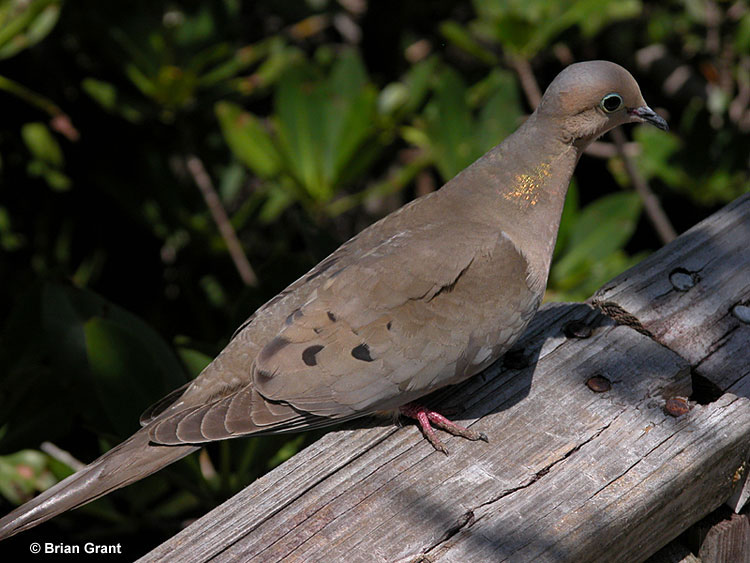
The Mourning Dove is a medium-sized, slender and pale brown dove with a long, pointed tail. It has a dark, slender bill, a narrow gray eyering, and short, reddish-pink legs and feet.
This species is pale brown and buff overall with some gray, especially on the rump and tail. The underside of the tail has white tips, and it has some black spotting on fairly long wings.
This bird also has a small black spot on the lower side of the face, and a small patch of golden iridescence on the side of the neck.
Mourning Doves feed on seeds and grain. They forage by picking those food items from lawns and other open spots on the ground, and also visit bird feeders. Although they are often seen on their own, Mourning Doves can form small flocks during the winter months.
The low-pitched “hooting” calls of this species are commonly heard in parks, gardens, woodlands, and many urbanized areas.
8. Chipping Sparrows
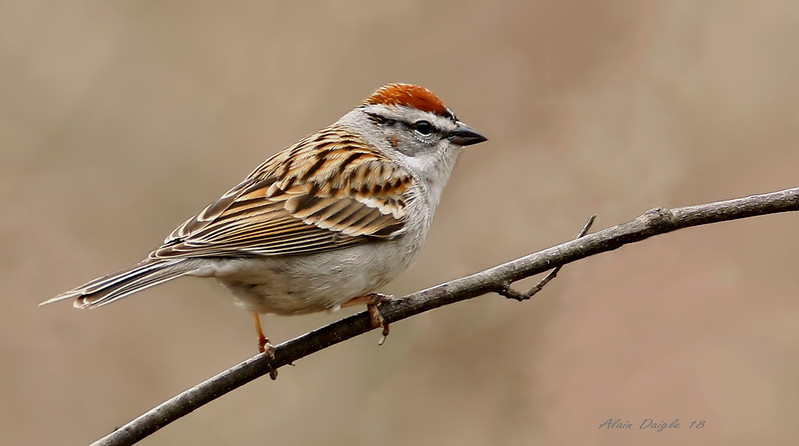
© Alain Daigle
The Chipping Sparrow is a small sparrow with a slender, conical, black bill, rufous cap, and black line through the eye. It has narrow white crescents above and below the eyes, a pale eyebrow, and gray on the face and side of the neck.
The rest of the underparts, rump and lower back are gray, and the upper back is brown with black streaks. The longish, slightly forked tail is pale brown, and the rounded wings pale brown with some black markings and two pale wing bars. In the fall and winter, the Chipping Sparrow has a pale bill, and is browner on the crown and face.
This small species is a very typical bird of parks and other semi-open habitats with spruce and other conifers. It feeds on seeds and insects in open, grassy areas, and forages by hopping and using its bill to pick food off the ground.
In spring and summer, the mechanical, trilling song of the Chipping Sparrow is a common feature of parks and suburban areas. This species flocks together and with other sparrows during the winter.
9. Song Sparrows
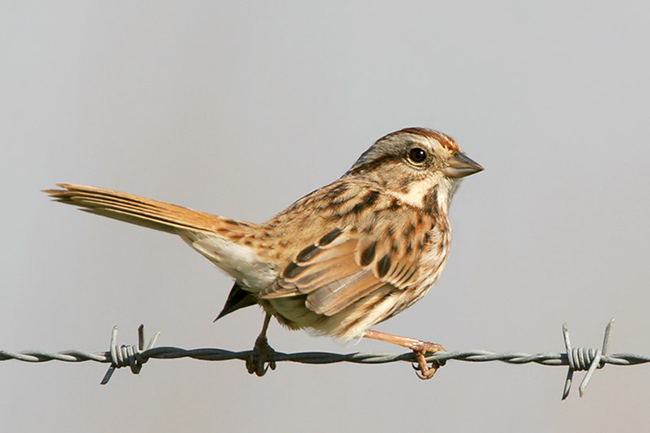
The Song Sparrow is a smallish bird with a slender, conical bill. Male and female birds look the same and have brown and gray on the crown and on the face, a narrow buff eyering, and a buff moustache area bordered with dark brown markings.
This sparrow has pale underparts with a dark brown spot on the breast and dark brown streaks on the sides, and brown upperparts with some dark streaks. The brown tail is rather long and slightly rounded, and the brown wings have two, narrow white wing bars.
The Song Sparrow feeds on seeds and insects in brushy areas and other edge habitats. It forages by using its bill to pick food items off of bushes and from the ground. It can also visit feeders, often eating spilled seed rather than taking food from the feeder itself.
The cheerful song of the male is a common sign of spring and summer throughout Michigan.
10. Common Grackles
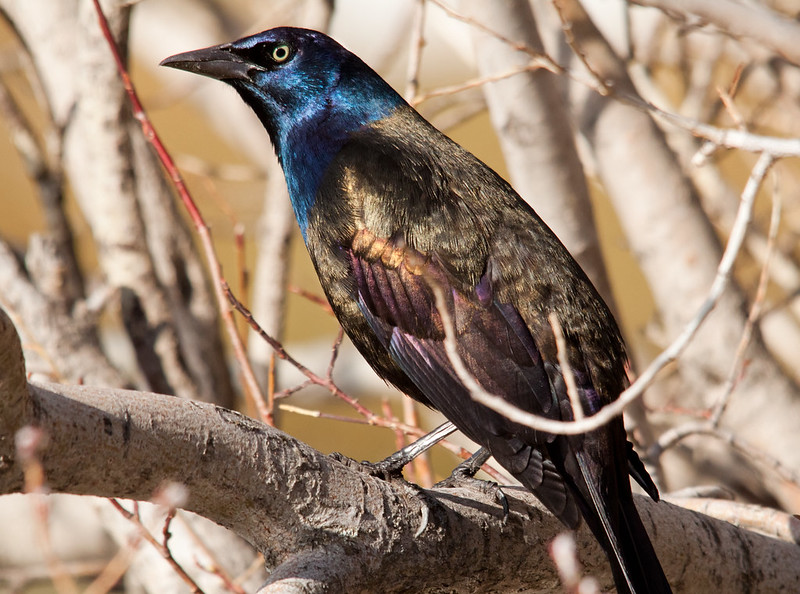
© Shawn McCready
The Common Grackle is a fairly large, long-tailed bird with a pale eye, and blackish plumage with purple, dark blue, and bronze highlights.
It has a stout, strong bill, medium-length wings, and rather long, strong legs and feet. Males and females look similar except that females have duller plumage and shorter tails. The male Common Grackle has a long, wedge-shaped tail with a distinctive, semi-folded shape, especially in flight.
This species is a very adaptable bird that mostly feeds on grain, acorns, seeds, fruit, and insects, but will also eat other small creatures, including bird eggs, nestlings, and small fish.
The Common Grackle does most of its foraging on the ground, often feeding in fields, wetlands, and other open habitats with blackbirds and Starlings. It uses its bill to pick food from the ground but can also take food from bushes and trees. In winter and migration, it can occur in huge flocks numbering in the thousands.
11. Ovenbirds
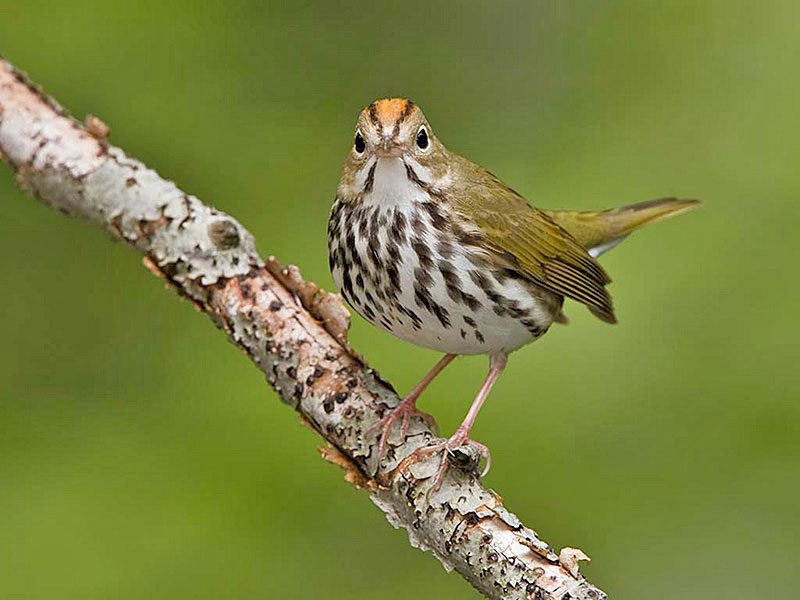
The Ovenbird is a terrestrial warbler species with olive upperparts, a white eyering, and a narrow orange stripe on a crown bordered with black.
It has a fairly short and pointed, pinkish and gray bill, pink legs, and white underparts with a short black line on each side of the throat, and black streaks on the breast and flanks. Males, females, and young birds look the same.
The Ovenbird lives in old second-growth and forest habitats, feeding on small insects. This species forages by steadily walking across the forest floor and picking food items from the ground with its bill. When searching for food, it may turn over or look under leaves, and walks with its tail cocked up like a miniature bantam rooster.
The loud and staccato, “teacher, teacher, TEACHER!” song of the Ovenbird is often heard in woodlands during the summer. In fall, it migrates to the Caribbean, southern Mexico, and Central America.
12. Blue Jays
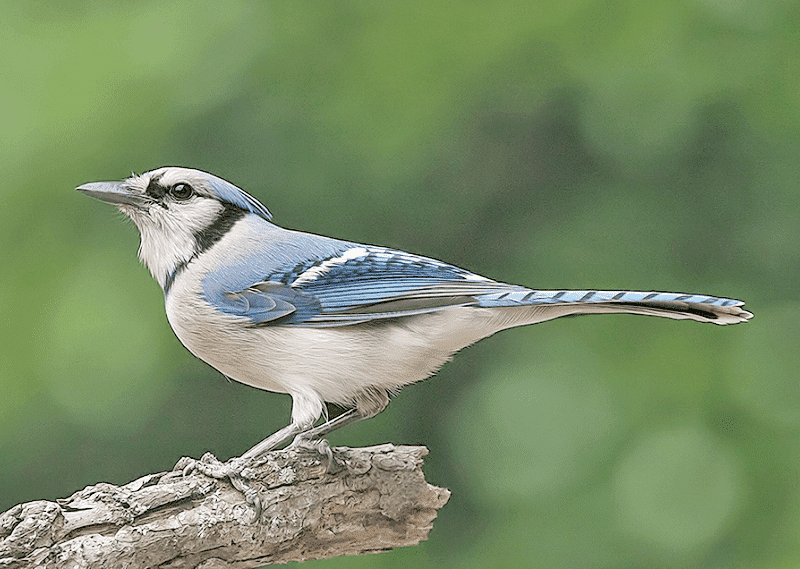
Photograph © Alan Wilson.
The Blue Jay is a fairly large, slender, crested bird with a strong, stout black bill. Males and females look the same, have a powder blue crest and back, a white face with a narrow black line through and in front of the eye, and black bordering the back edge of the face and throat to form a thin black collar.
The wings and tail are brighter blue with black bands and white markings, and the underparts are pale gray with white on the throat and belly.
Blue Jays feed on acorns, other nuts, seeds, large insects like dragonflies and cicadas, fruit, and other items. They can also eat carrion, are frequent nest predators, and visit feeders to eat sunflowers seeds.
This species forages by using its bill to pick food from foliage and twigs, sallying to catch insects in flight, and also picks nuts and seeds from the ground. Blue Jays can form small flocks, especially in the winter, and they have a variety of calls, including the commonly heard, “Jee-er! Jee-er!”.
13. Northern Cardinals

© Elaine R. Wilson
The Northern Cardinal is a handsome, thrush-sized bird with a prominent crest, and a large, conical, orange-red bill. The male is mostly bright red with black on the face and throat, and dusky red on the back, wings, and tail. The female is overall pale brown with red highlights in the wings, tail, and crest, and has less black on the face and throat.
In flight, the tail of the Northern Cardinal is fairly long and shows a rounded tip.
The Northern Cardinal feeds on the seeds and fruits of Wild Grapes, Sedge, Dogwood, Sumac, and other plant species. It also visits feeders (they like black-oil sunflower seeds) and during spring and summer, eats flower buds, grasshoppers, and many other insects.
This handsome bird forages by using its bill to pick food from the ground, and by picking insects from foliage in bushes and trees. The sweet, whistled song of this species is often heard in gardens, parks, edge habitats, and neighborhoods throughout Michigan except for parts of the Upper Peninsula.
14. Black-capped Chickadees
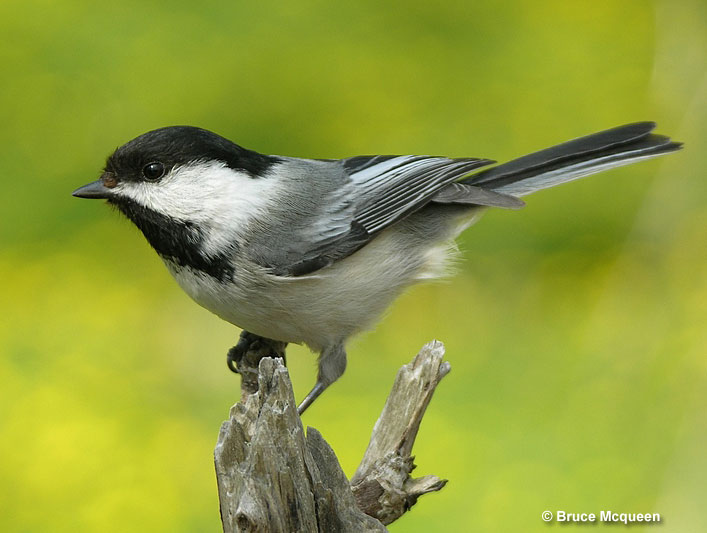
The Black-capped Chickadee is a small, appealing bird of parks, woodlands, and big gardens. Males and females look the same and have a prominent black cap, black throat, and white on the face that extends to the back of the neck.
They have short, stout black beaks, pale brown-gray upperparts, white bellies, and have some white edging on the feathers in the wings. They often use their strong feet to grasp twigs and forage while hanging upside down or sideways.
The Black-capped Chickadee feeds on seeds, berries, caterpillars, small insects, spiders, and often forages in flocks with other chickadees and small birds. This cheerful bird is also regular at backyards and feeders, where it enjoys seeds and suet.
Chickadees forage by inspecting bark, twigs, and leaves, and then use their bills to pick insects and spiders from hiding spots. This acrobatic species can also sally and catch insects in flight, and occasionally picks up seeds from the ground.
The nasal “dee dee dee” and whistled “fee-bee” calls lend a happy touch to gardens and woodlands throughout the state.
15. Barn Swallows
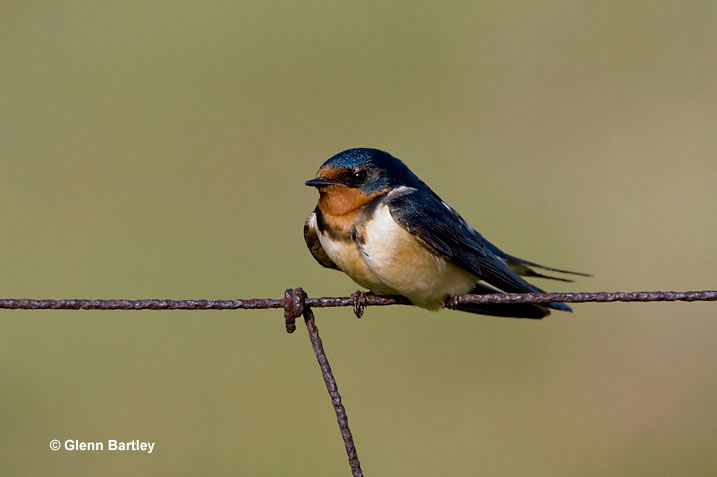
The Barn Swallow is an elegant and aerial species with a long, forked tail, dark blackish-blue upperparts, and reddish-orange on the throat and in front of the short bill.
The color of the throat is separated from the breast by a narrow black-blue line and the rest of the underparts are an orange-peach color. When the tail is spread, it shows a spotted, white band. Males have a longer tail than females and darker colors on the underparts whereas juvenile Barn Swallows have much shorter tails and more subdued colors.
Barn Swallows feed on flying insects over farmlands, wetlands, and other open habitats throughout Michigan. They forage by quickly flying over fields and other habitats and catching small insects with their bills.
This species usually flies closer to the ground than other swallows and often catches insects flushed by farm machinery, cows, and people walking through the grass.
Barn Swallows arrive in Michigan for breeding season, and after breeding, they form large flocks that migrate long distances to areas from Mexico all the way south to southern Argentina.
16. House Wrens
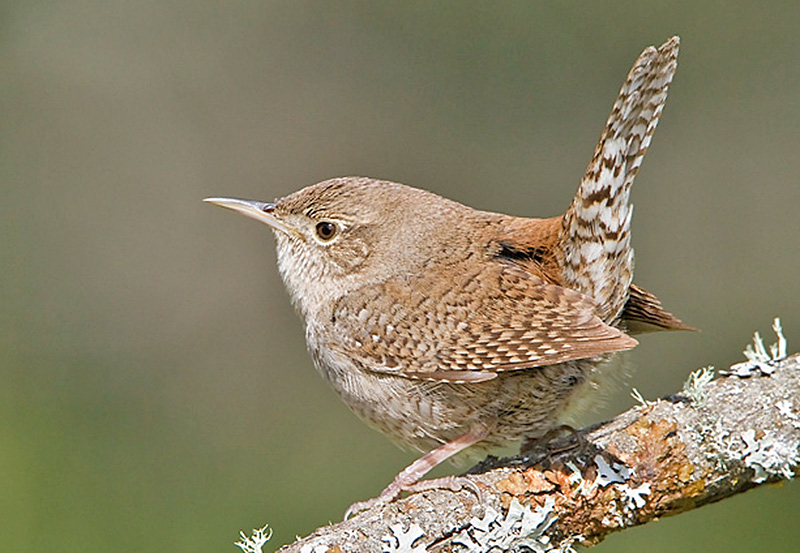
Photograph © Glenn Bartley.
House Wren is a small and confiding grayish-brown bird with a pale throat and a longish, slightly curved bill. It has a hint of an eyering and dark line behind the eye, and small dark bands on the brown and buff wings, lower back, rufous-brown tail, and undertail. Males and females look the same and juveniles are also very similar but have more buff coloration.
House Wrens also have short, rounded wings, and a medium-length, rounded tail often held slightly cocked up.
The House Wren feeds on spiders, small bugs, moths, caterpillars, and other small insects. It forages on and near the ground by using its bill to pick food items from leaves, twigs, the ground, and nooks and crannies of bark and other hiding places.
House Wrens occur in pairs and are common in gardens, parks, and any habitat with some vegetation and cavities for nesting.
17. Common Yellowthroats
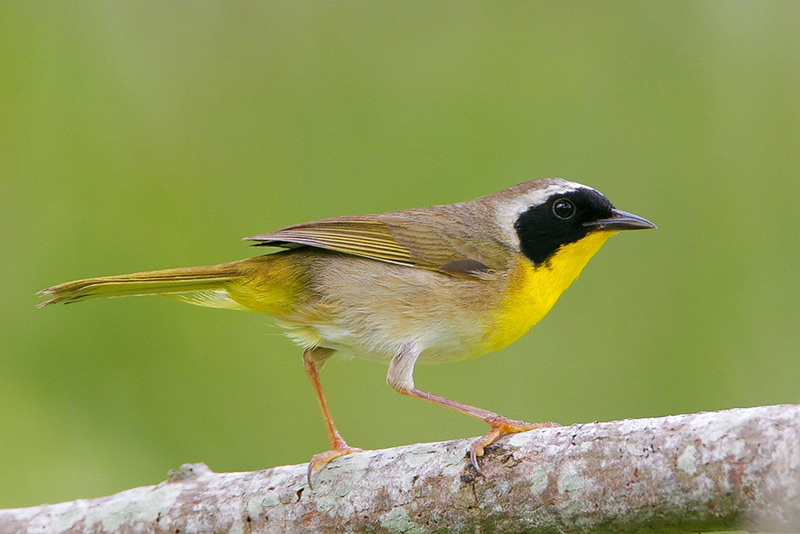
Photograph © Greg Lavaty.
The Common Yellowthroat is a small, brownish warbler with yellow on the throat, breast, and under the tail. The male has a black bill and a prominent black mask partially bordered with white or pale gray.
Female and young Common Yellowthroats lack the black mask, have a hint of a pale eyering, and a pinkish bill. This species also has rounded wings, a medium-length tail, and pink legs and feet.
This small warbler feeds on small insects and arthropods in wet grassy habitats, wet second growth, and freshwater marshes. It forages by picking food items from vegetation and the ground in wet areas.
The “whichety-witchety-witchety” song of this species is a common summer sound near lakes and other wetlands throughout Michigan. After summer, it migrates to the southern USA, Mexico, the Caribbean, and Central America.
18. Cedar Waxwings
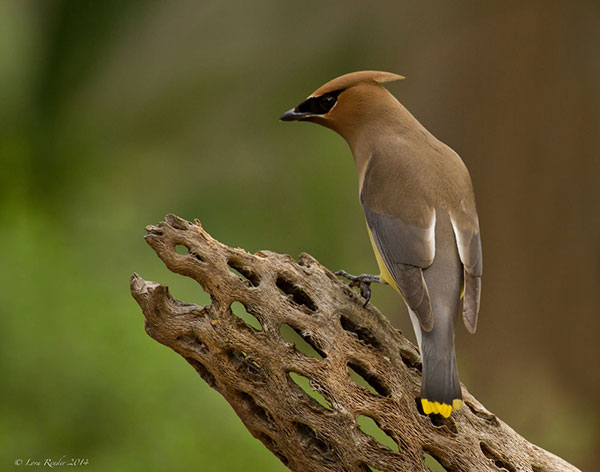
The Cedar Waxwing is a sleek, pale brown bird with a crest and a narrow, black mask. Both sexes look the same and also have a slate-gray back and wings, pale yellow on the belly, and a dark gray tail with a yellow tip.
The long wings also have a bit of white and can be ornamented with a few small, red balls of a wax-like substance. Juvenile waxwings are like adults but are duskier gray with some thick streaks.
This pleasant species feeds on berries and small fruits, and insects. It forages by using its small black bill to pick fruits and berries while perched in bushes and trees, and sallies into the air to catch insects.
Cedar Waxwings usually occur in flocks and their lazy, high-pitched whispering vocalizations can be heard in parks and woodlands throughout Michigan.
19. Indigo Buntings
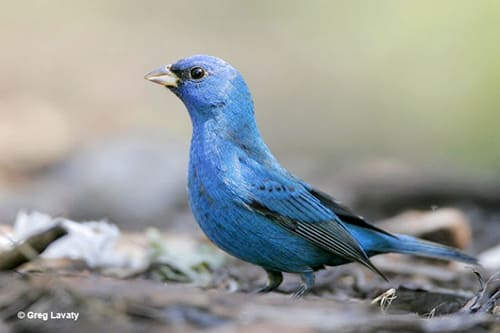
The Indigo Bunting is a small, sparrow-sized, finch-like bird with a conical, grayish bill. Male Indigo Buntings are deep blue with black in front of the eye, and in the wings and tail.
In certain lighting, they can appear to be all black. Females and juveniles are brown above, pale below with some indistinct streaking, can have a faint buff eyering, and can have blue highlights in the wings and tail.
This bunting species feeds on seeds and insects. It forages by using its bill to pick spiders, insects, and seeds from the ground and low vegetation, usually in thick, brushy habitats.
Indigo Buntings are common birds of brushy habitats, and the males often sing a song of warbling phrases from the top of a small tree. They migrate to Mexico and the Caribbean south to northern Colombia.
20. American Goldfinchs

© Alan D. Wilson
Often known as the “Wild Canary”, the American Goldfinch is a small and beautiful finch often seen at feeders. The breeding male is bright yellow with an orange bill, black cap, and has white markings in long black wings and a rather short, black, forked tail.
Females and winter males are pale buff and brown with yellow highlights on the head, have a dark bill, and yellow in the wings.
The American Goldfinch feeds on seeds of thistle, elm, and other species, and the occasional insect. It forages by picking seeds with its bill while perched on a stalk or branch. For most of the year, this species occurs in flocks of a dozen to 200 birds.
The cheerful “per-chickory” call of the American Goldfinch is commonly heard in gardens, open fields, and brushy habitats throughout Michigan.
21. Canada Gooses
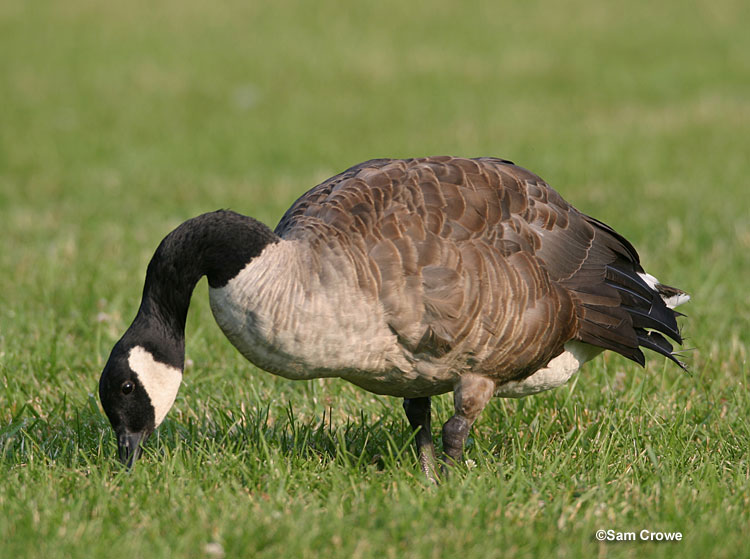
The Canada Goose is a large, grayish-brown goose with a long black neck, and a black head with a white patch on the face and throat. It has faint pale edging to the feathers on the back, wings, and most of the underparts, and a large area of white on the lower belly and under the tail.
The back and long wings are darker than the underparts, the strong legs and webbed feet are grayish, and the duck-like bill is black. Male and female Canada Geese look the same.
This hefty bird feeds on grasses and other types of vegetation in and near wetlands, including golf courses and parks. It forages by walking in grassy areas and using its long neck to reach down and graze with its bill. In water, it also dips its head and neck to nip vegetation growing beneath the surface.
In defense of its young, the Canada Goose makes hissing sounds and can bite, and hit with its wings. More often, we hear its loud honking calls in parks and wetlands throughout the state.
Questions About Michigan Birds
What kind of bird is only found in Michigan?
The Kirtland’s Warbler. The breeding area of this warbler species is almost entirely restricted to Jack Pine forests in Michigan.
What bird is Michigan known for?
The Kirtland’s Warbler. This warbler species is almost entirely restricted to Jack Pine forests in Michigan.
What big birds are native to Michigan?
Big birds native to Michigan include the Sandhill Crane, Great Blue Heron, Turkey Vulture, and the Bald Eagle.
How many bird species are native to Michigan?
The official bird list for Michigan has 459 species. Of those species, 346 are regular, four no longer occur, and 139 are accidental or casual visitors to the state.
What rare bird was spotted in Michigan?
The Kirtland’s Warbler is a rare species commonly spotted in Michigan during the summer. Other rare birds spotted in Michigan have been the Common Redshank (a vagrant from Europe seen in 2022), Neotropic Cormorant, and Black-necked Stilt.
What bird sounds like it’s laughing in Michigan?
The Northern Flicker and the Pileated Woodpecker are two species in Michigan that sound like they are laughing.
Are there hummingbirds in Michigan?
Michigan has one species – Ruby-throated Hummingbirds that arrive by May to breed and leave by October. Keep in mind, that it’s worth keeping your hummingbird feeders up for some time in the fall, as hummingbirds might need some extra energy.
Are there any other common birds that didn’t make it to the list?
The list of birds you can see in Michigan is neverending (at least it feels so), so there are always more birds you can see, starting from the Hairy Woodpecker, Red-bellied Woodpeckers, and Downy Woodpeckers, ending with Tufted Titmouse, House Finches, Baltimore Orioles, and the White-throated Sparrow.
Even some hawks can be found in Michigan, such as the Red-tailed Hawk.
Read Next: Hawks in Michigan | Woodpeckers in Michigan | Ducks in Michigan | Hummingbirds in Michigan

